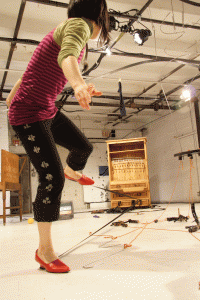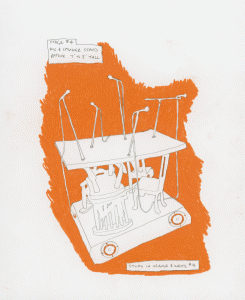« Features
Lasting Looks? The 75th Whitney Biennial / Interview with Gary Carrión-Murayari
The 2008 Whitney Biennial had me prowling the large halls of the Park Avenue Armory and participating in a performance while sipping absinthe. The upcoming 2010 biennial promises to be less sprawling and perhaps, in tune with the economic crisis that has erupted since, a bit more sobering. It also simply might be the case of a different kind of ambition. As this year’s co-curator Gary Carrión-Murayari explains in our interview, they are not only placing their best bet for the present direction of American art, but they are also foregrounding the venerable past of the Whitney biennial, as the parallel show “Collecting Biennials,” with works acquired by the Whitney from previous biennials, and a catalogue with ample historical materials can attest to. While we might not know which of this year’s artists will make a lasting impact in the history of American art, Carrión-Murayari is sure that the Whitney Biennial will continue to do so.
By Maja Horn
Forecasting the 2010 Whitney Biennial
Maja Horn - The 75th Whitney Biennial will be opening on February 25, but there are already some comments circulating about the selection process and about what it is shaping up to look like. Some of the things that have been mentioned are that it will be a smaller biennial; that, unlike the last one, it will be mostly contained within the museum itself; and that women, for the first time, will be representing over 50% of the participating artists. Besides these initial observations, I wanted you to forecast a little bit. What do you think critics will notice about this biennial after it actually opens to the public or what do you hope will be noted?
Gary Carrión-Murayari - That initial response to the list is always very speculative. I have read some discussions that were just looking at the numbers, which I think are a misleading thing. But there have been some more careful and well-considered [discussions], looking at individual artists in the show, and that is hopefully what people will take away from it - [to] really judge the artists in the show on their own merits, and then judge the show on its own merits. I also think one of the benefits of having fewer artists in the show is that you have more control over the pacing of the show. In most biennials where there have been hundreds of artists or a hundred artists, it is really easy for an artist that you care about to get lost in that installation, in that struggle to find space for everyone. With this number of artists we have been able to construct a show, construct an experience that hopefully will be provocative and successful for the viewers.
M.H. - When you say “provocative,” is there anything that you think will stand out? [...]
G.C.M. - You can never really guess how critics are going to respond. That is why you can’t really think too much about critical responses beforehand, because people pick up on different things. And the interesting thing about the biennial is that there really is a difference between a curatorial perspective and a critical perspective, and both of them are completely subjective in their own ways. So, I don’t know what is going to be “provocative” to people necessarily. I know what was exciting for us: all the artists in the show; it was exciting for us to include them.

Josephine Meckseper, Mall of America, 2009, video, transferred to DVD, color, sound; 12:48 min. Collection of the artist; courtesy VG Bild-Kunst, Bonn.
One thing we are doing is, in the catalogue we have been looking at the history of biennials very closely for this collection show (”Collecting Biennials” on view until November 28). The catalogue is going to have lists of all prior biennial artists going back to the thirties, as well as old installation shots, and then selected reviews from the history of the biennial, some of them are very positive, and we also included some very, very negative ones. However, those reviews do not necessarily correspond to how we evaluate those biennials or those artists now. So, both practices are subjective and fallible to a certain degree.
On Collaboration, Selection, and the Whitney Collection
M.H. - You are the co-curator with Francesco Bonami, and, between the two of you, you are seen as representing the next generation of curators and the “up-and-coming.” I wonder, when it came to the selection process, which parameters did you both easily settle on, or were there also any concerns that you specifically found yourself pushing for?
G.C.M. - It was great to do this with a curator who is so experienced, but also it was good to do this with a curator who is so open and supportive of younger curators. Francesco and I have known each other for a few years now [...], so I never really felt like I had to push for anything. But also, it was a wonderful experience of his bringing artists to the table and my bringing artists to the table and really having that kind of process of discovery together with other artists. I would be hard-pressed to draw a line in the show and say “these are my people and these are his people.” There was a consensus in what we were doing, and so there was no real haggling over artists. Part of that too is that we didn’t wait until the end to invite all the artists; we did it along the way. So, if we saw an artist that we were both really excited about, we invited him/her to the show. We had really great discussions about what we were seeing and trends that we were observing, but the best part is the process of discovery. All these studio visits you are going on; it is artists opening up their work processes and their concerns to you. It is really more about that than about haggling over artists.
M.H. - Once you agreed upon an artist, what about picking that one work that you wanted to represent the artist?
G.C.M. - We knew we wanted to show new work by all the artists, artists’ [work] that hadn’t at least been shown in New York, but that for the most part hadn’t been shown at all. We weren’t telling artists “produce whatever you want for the biennial,” that was not really what we were trying to do, because we were trying to build an exhibition not necessarily just a random collection of contemporary work. If an artist was working on a new project that we were excited about, that’s what we would invite. Nobody was really invited just because we thought they were great and should be in the show … well, there are maybe a couple. But for the most part we were really trying to construct this as we were going along. We certainly discussed the recent work with the artist, but the final decision rests with us.
M.H. - So could you mention two or three artists that for you best characterize some of the directions of this year’s biennial and, in broader terms, currents in American art right now?
G.C.M. - Sure, I think there is a fair amount of performance in the show, and one artist that is going to have a pretty visible presence within the show is Aki Sasamoto. She is going to be doing a pretty small, room-sized installation, but she is going to be performing fifteen or twenty times during the course of the biennial on the floor, during the day, while [the museum] is open to the public. There are other platforms for performances that are going to be happening. In the lobby gallery, there is a sculptural installation by Martin Kersels, and then there are large-scale sculptures that are going to function as a stage for performances, so he is picking dancers, and writers, and musicians, and there will be some educational programming too. It will be very dynamic, active, and I think that speaks to the nature of contemporary practice; it is interdisciplinary, but there is also a sense of collaboration.

Aki Sasamoto, still from Secrets of My Mother's Child, 2009, performance and installation. Collection of the artist. Photo: Arturo Vidich
There is a lot of painting in the show. Both of us care quite deeply about painting, and I think it is something that will never go away. We have older and younger painters, people who work in abstraction or figuration; someone like Suzan Frecon, who is in her sixties, a more established figure who hasn’t gotten that much exposure, and then there are younger painters like Tauba Auerbach and Sarah Crowner who are looking at abstraction from a different perspective.
M.H. - This year the biennial is simply titled “2010,” which further foregrounds its role as a pulse-taker of American art, and then, on the other hand, you also have mentioned that it is not only about the artwork’s timeliness in some ways but also about investments in the long-term, given that the biennial does play a role in the museum’s acquisitions process and collection-building. That is definitely something you are also focusing on in the catalogue and the current exhibit, “Collecting Biennials.” Could you say something about how these different roles or purposes of the biennial shaped your curatorial work, and did you, at any point, feel that rather than going hand-in-hand they were working against each other?
G.C.M. - The struggle is, especially when you start looking at the history of the biennial, … to evaluate the contemporary for its future importance. In the collection show we have some very recognizable names who are in biennials, sometimes many times, sometimes only a couple times, one was only in two biennials, but then there are those people who were in fifteen or twenty biennials, whom you probably never heard of before. So, it is always a process of speculation. The biennial, as much as outside interpreters like to believe that it launches young careers, does not necessarily do that. To a certain degree we are putting these artists out there because we do feel that they stand for contemporary art at this moment, but when we look back, some may still be around and some may not. I think there are a fair amount of artists in the show who will continue to contribute at least to our immediate art historical discussion. That is the challenge. You can’t really try to put together a show in which you have fifty artists that you are completely sure will be household names twenty years from now.
American Art?
M.H. - One of the qualifiers of the Whitney Biennial is that it is supposed to be of “American art.” In Frieze Magazine, your co-curator Bonani mentioned that there are several foreign-born artists in the show, and he defines artists as “American” by saying that “most of them have digested the culture in a particular American way that was relevant.” I was wondering what role the qualifier “American” played for you in the curating process?

Martin Kersels, Study in Orange & White #4, 2009, colored pencil on paper, 14” x 11”. Collection of the artist. Courtesy Galerie Georges-Philippe & Nathalie Vallois, Paris, and Mitchell-Innes & Nash, New York
G.C.M. - We used the same sort of distinction. All of the artists generally live in New York, and some of the Americans spend time abroad. The fact that artists were born abroad shouldn’t necessarily be an issue. That has been the case with biennials going back to the thirties … Dalí was in a biennial at some point in the thirties. They are about artists who have been here for a significant amount of time and do not necessarily represent “Americaness,” but have to be comfortable as part of this discussion of what American art is. Obviously in American life in general, but especially in the art world, we are enriched by voices that come from different backgrounds, people who want to be more conservative about that definition … What? Are you only supposed to include white men or something like that? I don’t think that would make sense either. There are artists who live in the United States and who are from Europe or from other places, who don’t feel that they are participating in a discussion. They are doing what feels “German” or feels “Italian” …. It is kind of a subjective definition, but I do think that it is, again looking at the history of the biennial, a discussion that becomes a bit irrelevant to the larger field.
M.H. - If artists either are not American or may not be comfortable participating in a discussion of American art … do you think that this is an organizing category that will definitely be something to hold on to, or is it something that might need revision?
G.C.M. - I think so. I think we will hold on to that category. It does mean something; we have an artistic community here, and that is true in other cities too. We visited artists in Chicago and in Los Angeles too. It is a community and it is a discussion that takes place here, and I think that it is different than the ones that go on in other places, like London.
Biennials - Past and Present
M.H. - Besides being the co-curator for the upcoming biennial, there are two other Whitney Biennials that you in some form have contributed to or participated in, so that means you have been thinking about biennials for at least six years, if not more. So, I have two questions: Is there anything in the past that has informed your work for this biennial? Lessons learned? Things you wanted to do differently? Or something you really wanted to do in this one and haven’t been able to do before? And, then more broadly, have you seen the role of biennials changing over time?
G.C.M. - I worked on the 2004 and 2006 biennials with Chrissy Iles, so that definitely informed at least my desire to have a smaller biennial, in terms of the number of artists; just seeing how difficult it is to do exactly what you want once you get on the floor, even with the artists that you really care about, and during the selection process. This desire to have it contained in one building also comes from observing biennials in the past few years…not that great projects haven’t emerged from these offsite venues, but I do think it did dilute the experience of the biennial to a certain degree. Also, as far as the catalogue is concerned, from a really practical perspective, 2004 and 2006 were extremely interesting, constructive catalogues - the 2004 edition was the one in the box and the 2006 edition had these fold-out panels - and they were great catalogues, [but] we wanted something a little more like a traditional book, a little bit more comfortable to read, especially with this historical material, as well as a really nice and usable resource.
M.H. - There have been some comments about how biennials have become more commercialized, more like fairs, and how that might be negatively affecting the quality and validity of biennials. Do you perceive any of these changes and could you say to what extent you think a biennial is a valid and a distinctive platform?
G.C.M. - I can’t defend all biennials, and some are obviously better than others. At the Whitney, we have really been looking at why the Whitney Biennial is important and different and its engagement with American art as an essential part of it, and also how it is tied to this institution. I think Venice is older than the Whitney, but that is pretty much it, I think. The identity of this institution and our goal of supporting living American artists are built through the biennial; the biennial started two years after the museum opened. You mentioned the connection with the collection already, but also some of the younger artists in the show will appear in future Whitney shows. This is a very special relationship since it is an institutional biennial; however, in general, Venice hasn’t lost any relevance necessarily, and some of the other biennials in more far-flung places around the globe are also important in bringing a global discussion about contemporary art to different publics. That is always a useful thing. Maybe some are better than others, and it shifts from year to year, but I am not critical of biennials in general. Furthermore, you have seen some biennials in the past that have been very ambitious in their curatorial approach; I think that is what separates them from fairs. I think a little bit of that criticism about biennials being like fairs has waned in recent years as the market has slowed down. They are not the same thing and fairs are not necessarily the place where everybody is going. The fair is still an important part of the commercial art world, but that importance waxes and wanes. Something like the Whitney Biennial or Venice, however, is a continuously important show.
M.H. - Since you represent a new generation of curators, is there anything that you see changing or any challenges that you foresee that your generation will be facing?
G.C.M. - Absolutely, there is obviously a much, much larger group of curators working internationally, who are part of similar dialogues in different parts of the world, than when the people who are my mentors came up twenty years ago. There is also an increasingly larger pool of artists, who are also more aware of what is going on in other places in the world; it is a little bit tougher and more competitive for the artists. It is also a good thing for the public to become more engaged with contemporary art; we see that in New York for sure, but there are other cities where that is the case too. As a curator you have to be aware of what the larger public is going to experience in the shows, and hopefully it will be an opportunity to bring people into this discussion.
M.H. - Thanks for your time.
Maja Horn specializes in performance and visual art, both writing and lecturing on the subject after earning a Master’s in Performance Studies from New York University and completing a PhD in Romance Studies from Cornell University. She is currently an assistant professor in the Department of Spanish and Latin American Cultures at Barnard College in New York.



































